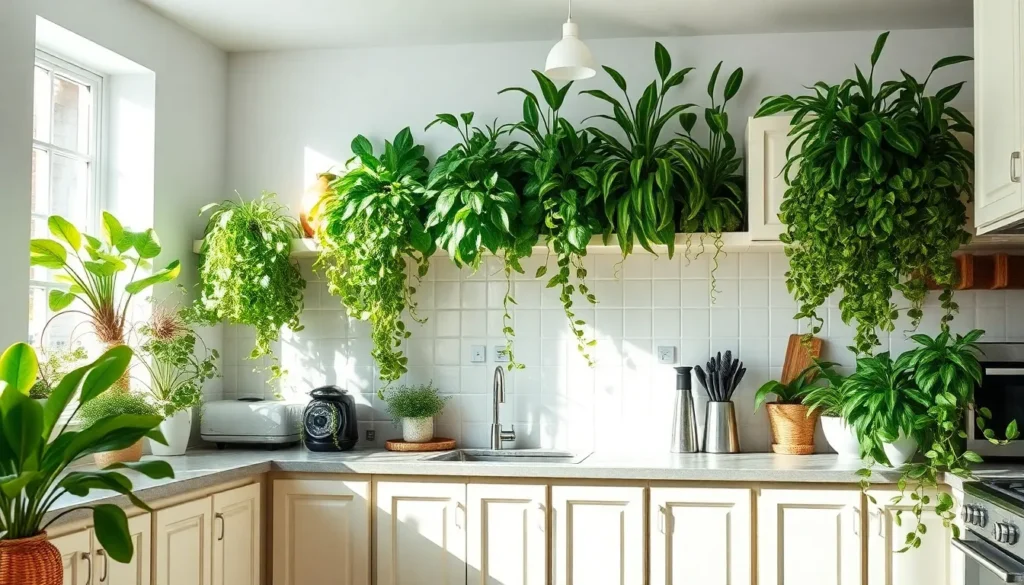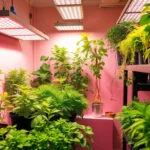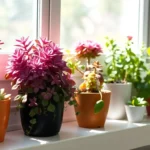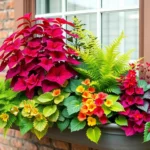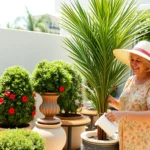We’ve all stared at that awkward empty space above our kitchen cabinets wondering what to do with it. That dead zone often becomes a dust collector or gets filled with random items that make our kitchen look cluttered and unfinished.
Plants above kitchen cabinets offer the perfect solution to transform this forgotten space into a stunning focal point. We’re talking about adding life color and natural beauty to an area that’s typically overlooked. The right plants can create visual interest draw the eye upward and make your kitchen feel more spacious and inviting.
Whether you’re dealing with a small galley kitchen or a spacious open-concept design adding greenery above your cabinets can dramatically change your kitchen’s entire aesthetic. We’ll show you exactly which plants thrive in this unique environment and how to style them for maximum impact.
Choose Low-Maintenance Plants That Thrive in Kitchen Conditions
Kitchen environments present unique challenges for plants, from temperature fluctuations to varying light conditions. We’ve selected hardy varieties that can handle these demanding conditions while requiring minimal care from busy homeowners.
Heat-Tolerant Varieties for Above-Stove Areas
Snake plants (Sansevieria trifasciata) excel in warm kitchen environments, withstanding temperatures up to 85°F without stress. These architectural beauties feature thick, upright leaves that create striking vertical lines above your cabinets. Their waxy coating helps them retain moisture even when exposed to cooking heat.
Jade plants (Crassula ovata) store water in their fleshy leaves, making them perfect for areas near stovetops where temperatures can spike. We recommend these succulents because they actually prefer slightly warmer conditions and can go weeks without watering. Their glossy, rounded leaves reflect kitchen lighting beautifully.
Ponytail palms (Beaucarnea recurvata) handle heat fluctuations better than most houseplants thanks to their swollen trunk base that stores water. These unique plants add tropical flair to kitchen spaces while tolerating the occasional blast of hot air from cooking activities. Their cascading leaves soften the hard lines of cabinet edges.
ZZ plants (Zamioculcas zamiifolia) thrive in warm conditions and can handle brief exposure to cooking steam without leaf damage. Their thick, waxy leaves naturally repel grease and cooking residue, making maintenance easier. These plants continue growing steadily even when temperatures vary throughout the day.
Humidity-Loving Plants for Steam-Rich Environments
Boston ferns (Nephrolepis exaltata) flourish in the humid conditions created by dishwashers, steam from cooking, and hot water use. These lush plants appreciate the extra moisture in kitchen air and will reward you with fuller, greener fronds. We suggest placing them away from direct heat sources while still benefiting from ambient humidity.
Peace lilies (Spathiphyllum wallisii) actually prefer the elevated humidity levels found in active kitchens over dry indoor air. Their dark green leaves and elegant white blooms create a sophisticated look above cabinets. These plants will droop slightly when they need water, making care timing obvious.
Air plants (Tillandsia species) absorb moisture directly from humid kitchen air through their specialized leaves. We love these epiphytes because they don’t need soil, making them perfect for creative displays on top of cabinets. Mist them weekly with kitchen steam providing additional humidity between waterings.
Spider plants (Chlorophytum comosum) generate baby plantlets more readily in humid environments, creating natural cascading displays. Their striped leaves add movement and texture above static cabinet lines. These plants benefit from occasional shower steam and can recover quickly from brief dry periods.
Low-Light Champions for Shadowy Cabinet Tops
Pothos varieties (Epipremnum aureum) excel in the reduced light conditions typically found above upper cabinets. Their trailing vines can cascade down cabinet fronts or be trained along the ceiling line for dramatic effect. Golden pothos, marble queen, and neon varieties all adapt well to kitchen lighting conditions.
Chinese evergreens (Aglaonema species) display colorful foliage patterns even in areas where natural light doesn’t reach directly. We recommend varieties with silver, pink, or red markings that catch and reflect available kitchen lighting. These plants maintain their vibrant colors better than many low-light alternatives.
Cast iron plants (Aspidistra elatior) earned their common name by surviving in extremely challenging conditions, including the dim spaces above kitchen cabinets. Their broad, dark green leaves create substantial visual impact without requiring bright light. These Victorian-era favorites can tolerate neglect better than almost any other houseplant.
Dracaena varieties (Dracaena marginata, Dracaena fragrans) adapt to various light levels while adding height and structure to cabinet top displays. Their sword-like leaves come in solid green or variegated patterns that complement kitchen color schemes. These plants grow slowly, maintaining their proportions for years without outgrowing their space.
Select Trailing Plants for Natural Cascading Effects
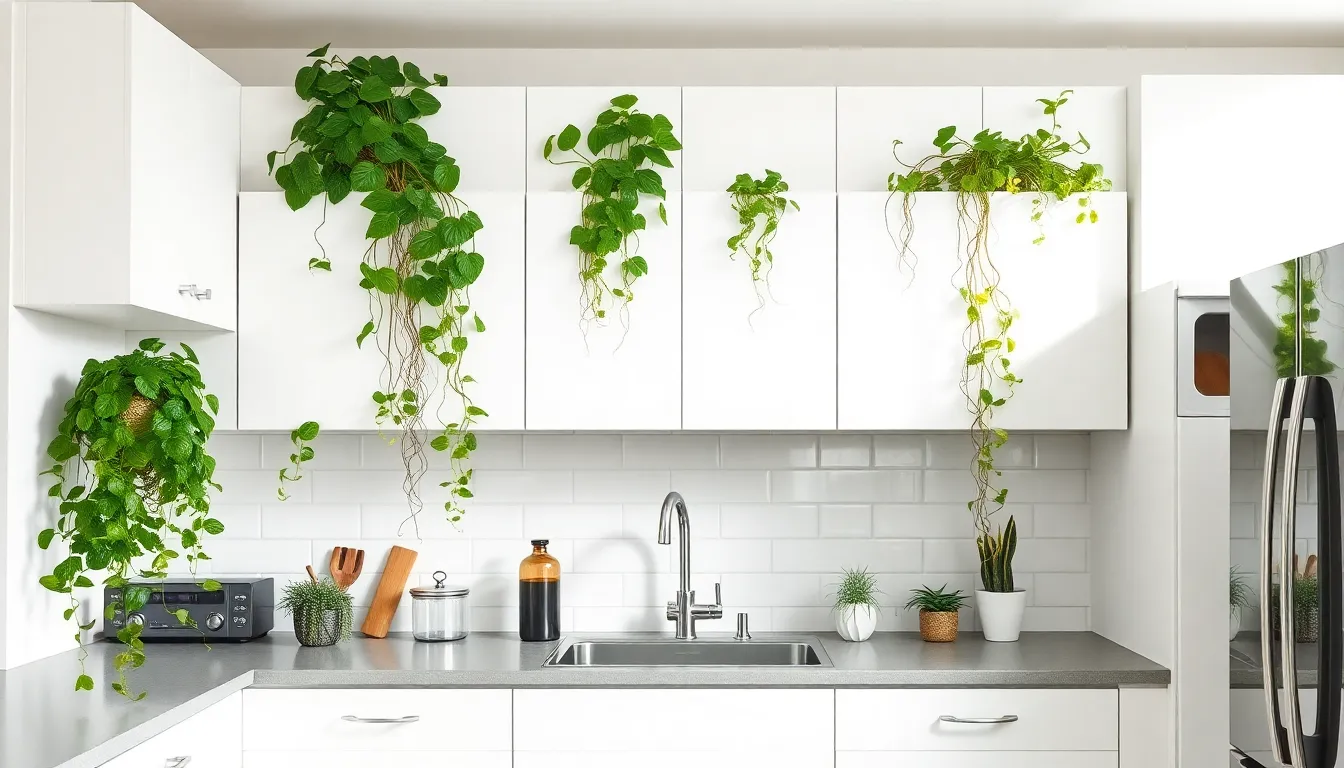
Trailing plants create the most dramatic visual impact when placed above kitchen cabinets because their naturally cascading growth patterns add movement and softness to hard cabinet lines. We’ve found that these draping varieties transform unused vertical space into living art that draws the eye upward and creates depth in your kitchen design.
Pothos and Philodendron Options
Pothos plants rank among the easiest houseplants we recommend for kitchen cabinet tops since they thrive in low to bright indirect light and tolerate irregular watering schedules. Their long trailing vines drape gracefully over cabinet edges while their tolerance for kitchen humidity helps them flourish in this steamy environment.
Devil’s Ivy varieties include golden pothos, marble queen pothos, and neon pothos that each offer different leaf colors and patterns to match your kitchen’s aesthetic. These hardy plants grow quickly and can extend several feet in length, creating lush cascading displays that require minimal maintenance.
Philodendron varieties perform similarly to pothos with their trailing growth habits and low maintenance requirements. We particularly recommend heartleaf philodendrons and brasil philodendrons for their ability to thrive in indirect light while adding rich green foliage that complements kitchen environments.
String of Hearts and String of Pearls
String of Hearts plants feature distinctive heart shaped leaves on thin trailing stems that create delicate cascading effects above kitchen cabinets. These succulent trailing plants prefer bright indirect light and need watering only when their soil becomes completely dry, making them perfect for busy homeowners.
String of Pearls plants offer unique bead like leaves on trailing stems that provide interesting textural contrast against traditional kitchen materials. Their unusual appearance adds modern appeal while their succulent nature means they store water in their leaves and require minimal watering attention.
Both succulent varieties create elegant, airy cascades that enhance kitchen decor without overwhelming the space. We recommend these plants for kitchens with good natural light exposure since they perform best in bright conditions compared to other trailing options.
Spider Plants for Easy Propagation
Spider plants adapt easily to kitchen conditions with their resilient nature and ability to thrive in indirect light while tolerating occasional neglect. Their arching leaves cascade naturally from cabinet tops while creating attractive fountains of green and white striped foliage.
Plant propagation becomes effortless with spider plants since they produce small plantlets called “babies” that dangle from the mother plant on thin stems. We love how these plantlets can be easily rooted in water or soil to create new plants for other areas of your home or to share with friends.
Chlorophytum comosum varieties include solid green spider plants and variegated types with white or cream stripes that brighten shadowy cabinet areas. Their ability to produce multiple plantlets makes them ideal for kitchen cabinets where maintenance time may be limited but you still want abundant greenery.
Opt for Artificial Plants for Zero-Maintenance Appeal
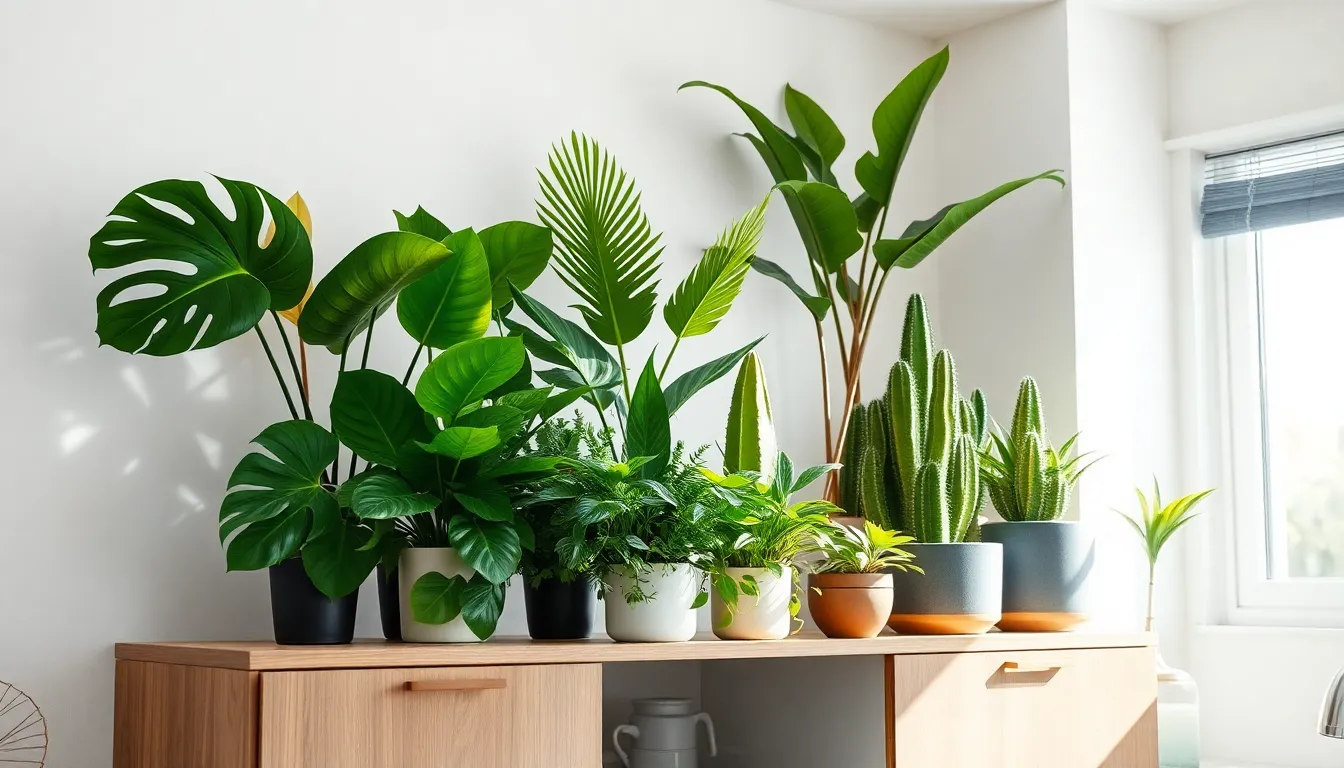
Artificial plants eliminate the challenges of caring for live greenery in hard-to-reach spaces above kitchen cabinets. We’ve found that synthetic options provide consistent beauty without requiring water, sunlight, pruning, or fertilizing.
High-Quality Silk Plant Options
Silk plants offer the most realistic appearance among artificial options, with modern manufacturing creating textures and colors that closely mimic living plants. Quality materials make these faux plants virtually indistinguishable from their living counterparts when viewed from ground level. We recommend investing in premium silk varieties that feature natural color variations and realistic leaf structures. These high-end options maintain their appearance longer and provide better value than cheaper alternatives that may look obviously artificial.
Realistic Faux Greenery Arrangements
Popular artificial plants for kitchen cabinet displays include silk Monstera, palms, birds of paradise, and cacti, which create year-round tropical or exotic vibes regardless of natural light conditions. Tall faux plants work exceptionally well above cabinets because they create dramatic focal points and help camouflage less attractive kitchen elements. We suggest mixing different plant types and heights to create natural-looking arrangements that draw the eye upward. Strategic placement of these synthetic plants can transform awkward cabinet top spaces into stunning design features.
UV-Resistant Materials for Sunny Kitchens
UV-resistant artificial plants prevent fading and deterioration in kitchens exposed to abundant sunlight throughout the day. These specially treated materials maintain their vibrant colors and structural integrity even when positioned near bright windows or skylights. We always recommend checking for UV protection when selecting artificial plants for sun-drenched kitchen spaces. This feature ensures your investment in faux greenery remains beautiful and fresh-looking for years while requiring only occasional dusting to maintain their appearance.
Position Plants Safely and Securely Above Cabinets
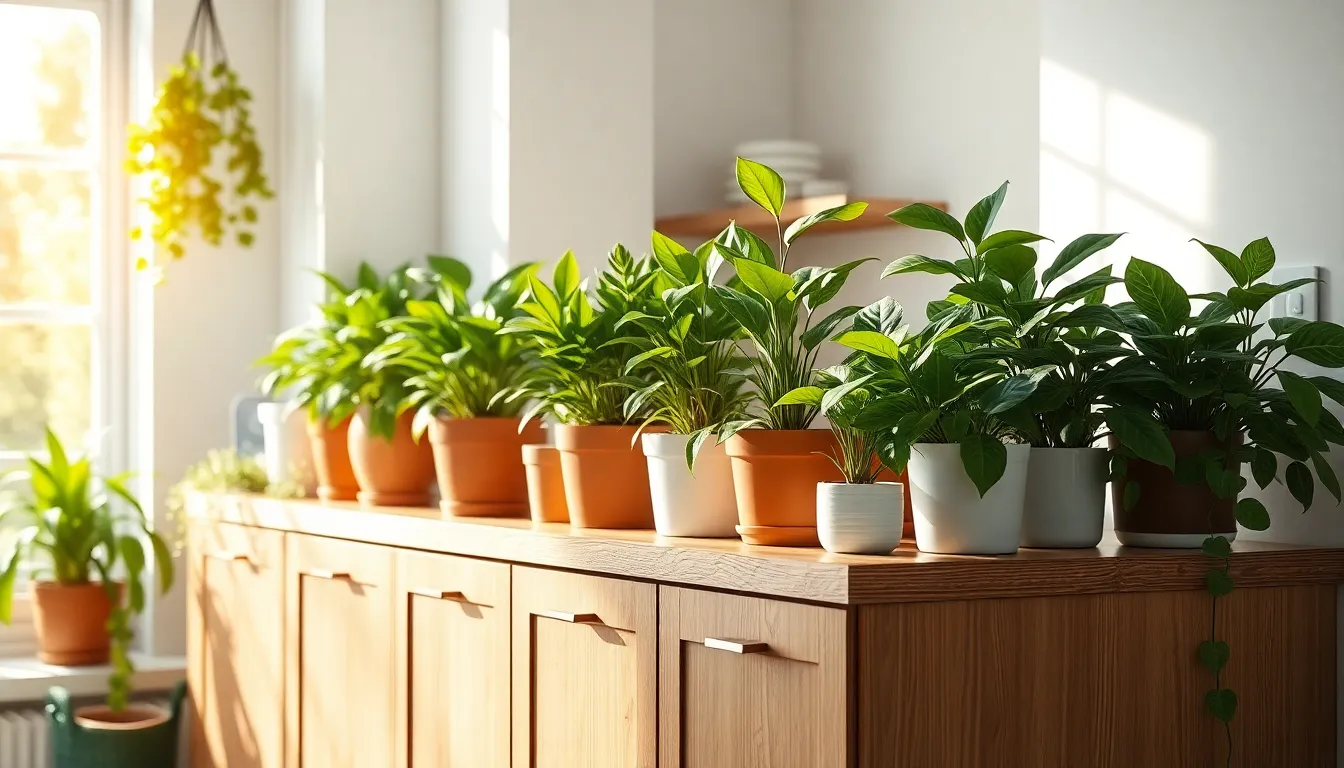
Once you’ve chosen your perfect kitchen cabinet plants, we need to ensure they’re positioned securely to prevent accidents and damage. Proper placement requires careful consideration of mounting systems, weight distribution, and accessibility for ongoing care.
Weight Distribution and Cabinet Support
Distribute weight evenly across multiple mounting points to prevent cabinet stress and potential damage. We recommend using brackets or mounts specifically designed for heavier loads, especially since watered plants weigh significantly more than dry ones.
Install sturdy wooden shelves or floating shelves that can handle the combined weight of pots, soil, and water. Multi-level stainless steel wire racks attached directly to cabinet frames offer excellent support and can accommodate several plants at once.
Avoid overloading single mounting points with heavy planters. Instead, we suggest spreading plants across the entire cabinet span to distribute weight more effectively and create a balanced visual display.
Proper Drainage Systems and Saucers
Use pots with drainage holes to prevent water from accumulating and damaging your cabinets or creating stagnant conditions that promote mold growth. Every plant container should have adequate drainage to maintain healthy root systems.
Place waterproof saucers or trays underneath each pot to catch excess water during watering sessions. We recommend checking and emptying these saucers regularly to prevent water from sitting too long and causing problems.
Water carefully using a long-spouted watering can to reach plants without spilling water onto cabinet surfaces. Water until drainage occurs from the bottom, then allow excess water to collect in saucers before discarding it.
Easy Access Routes for Maintenance
Create accessible pathways for regular plant care since cabinet-top plants sit out of normal reach. We suggest keeping a sturdy step stool nearby and using tools like long-spouted watering cans and extendable dusters for routine maintenance.
Take plants down periodically for thorough cleaning, pruning, and inspection. This allows us to rotate plants for even growth, trim overgrown trailing stems, and check for pest issues that might be harder to spot from below.
Monitor light conditions regularly and supplement with grow lights if necessary, particularly in kitchens with limited natural light exposure. We recommend checking plant health weekly and adjusting their positions as needed for optimal growth conditions.
Create Visual Balance with Strategic Plant Placement
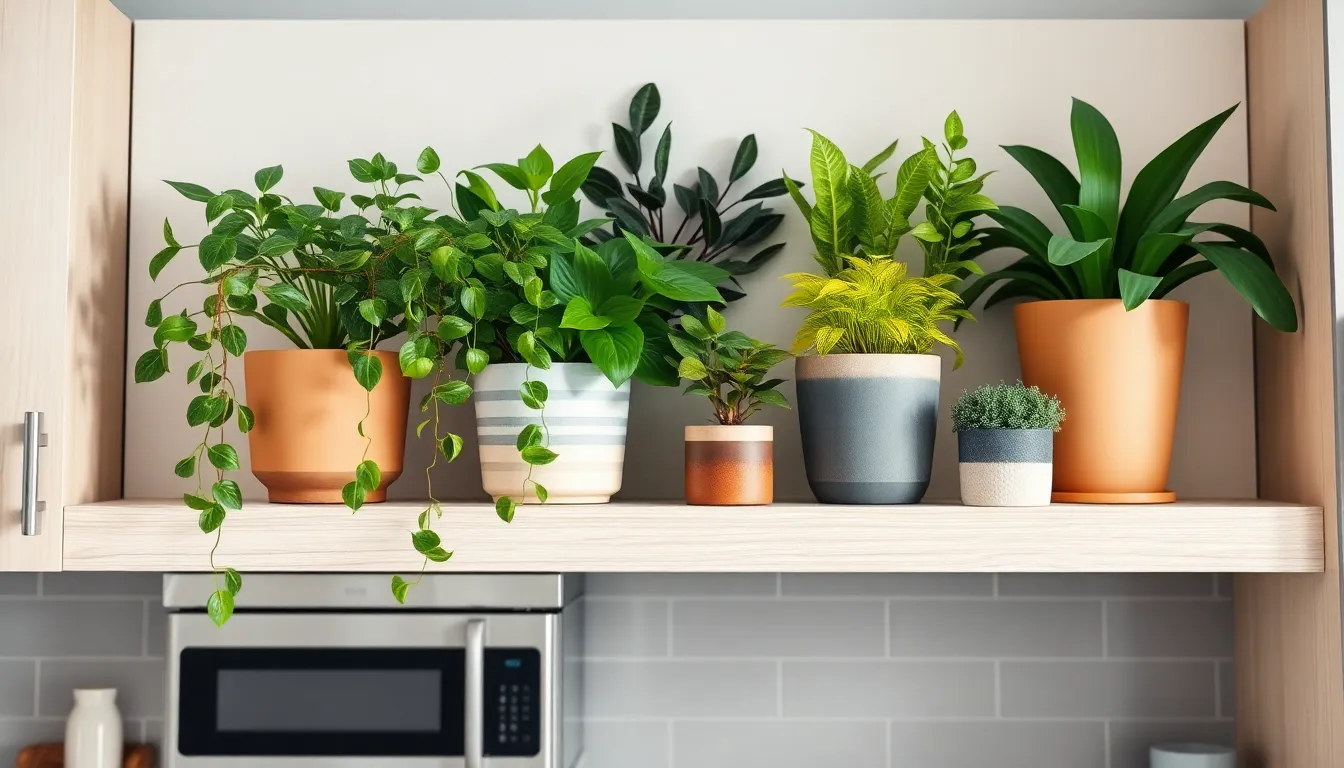
We’ll transform that empty space above your kitchen cabinets into a visually stunning focal point that enhances your entire kitchen’s aesthetic. Strategic placement creates harmony between your cabinetry and greenery while maximizing the impact of every plant you choose.
Grouping Techniques for Maximum Impact
Group 3-5 plants together to create the most visually appealing display above your kitchen cabinets. We recommend combining different plant shapes and textures to avoid monotony and establish a cohesive, lush appearance that draws the eye upward.
Choose containers that complement each other and match your kitchen’s existing decor style. Using pots in similar materials like ceramic, wicker, or metal creates unity across your plant grouping, turning the cabinet top into an intentional design feature rather than random plant placement.
Space plants evenly across the cabinet width to distribute visual weight effectively. We suggest leaving 6-12 inches between each plant grouping to prevent overcrowding while maintaining enough density to create that desired lush look.
Mix plant sizes within each group by pairing one larger statement plant with 2-3 smaller companions. This technique creates natural flow and prevents your display from looking too uniform or artificial.
Height Variation and Layering Methods
Position taller trailing plants like pothos or ivy at the back of your cabinet display to create depth and dimension. These cascading varieties add vertical interest and soften the hard lines of your cabinetry with their flowing foliage.
Place medium height succulents or compact herbs in the middle layer to bridge the gap between tall background plants and shorter front specimens. Aloe vera plants work exceptionally well in this middle position since they thrive in the bright, indirect light typical of cabinet tops.
Use shorter, bushier plants in the front row to complete your layered arrangement without blocking the view of taller plants behind them. Snake plants, jade plants, and ZZ plants excel in these front positions due to their compact growth habits.
Create stepping stone heights by varying pot sizes and plant stands to achieve a natural, tiered effect. We achieve this by using 2-3 different pot heights that gradually increase from front to back.
Color Coordination with Kitchen Decor
Match your pot colors to your kitchen’s existing color palette for seamless integration. Neutral colored containers blend beautifully with light cabinetry, while darker pots complement wood tones and create sophisticated contrast.
Consider your cabinet finish when selecting plant containers to ensure harmony rather than competition. White or cream pots enhance kitchens with painted cabinets, while natural materials like wicker or terracotta complement wood finishes.
Use plant foliage as your primary color accent, letting vibrant green leaves add that perfect pop of natural color to enliven your space. According to feng shui principles, this greenery above cabinets encourages positive energy flow throughout your kitchen.
Coordinate with your backsplash and countertop colors by choosing plants and pots that enhance rather than clash with these prominent features. Silver or metallic containers work beautifully with stainless steel appliances and modern backsplashes.
Maintain Plants Above Kitchen Cabinets Effectively

Successfully caring for plants positioned above kitchen cabinets requires exact techniques and consistent attention to their unique placement challenges.
Watering Strategies for Hard-to-Reach Areas
Testing the top inch of soil with your finger determines when your elevated plants need water. We recommend using watering cans with long spouts to reach plants without requiring step ladders for every watering session. Thorough watering until water drains prevents salt buildup that can damage root systems over time.
Cacti positioned above cabinets need water every 2-3 weeks or even monthly depending on the species and kitchen humidity levels. Misting leafy plants like philodendrons once weekly works effectively when soil watering becomes too challenging to perform regularly. Soaking these plants occasionally provides deep hydration without the mess of traditional watering methods.
Watering frequency varies significantly based on plant type and kitchen conditions. Snake plants and succulents require water only when their soil feels completely dry to the touch. Pothos and heartleaf philodendrons need consistent moisture but can tolerate brief dry periods between watings.
Cleaning and Dusting Techniques
Dust accumulation on high cabinet plants affects both their appearance and photosynthesis capacity. We suggest using feather dusters with long handles or attaching dusters to extendable poles for easy cleaning without climbing. Regular dusting prevents buildup that can clog leaf pores and reduce plant vitality.
Removing plants periodically for thorough leaf washing and soil refreshing maintains optimal plant health. Gentle wiping with damp cloths removes stubborn dust and kitchen grease that accumulates on leaf surfaces. Trimming yellow or dead leaves promptly keeps plants looking attractive and prevents pest problems from developing.
Kitchen steam and cooking residue create additional cleaning challenges for elevated plants. Rotating plants to accessible areas monthly allows for detailed cleaning and inspection of soil conditions. Professional plant care becomes easier when you establish a regular maintenance routine.
Rotation Schedules for Even Growth
Rotating plants regularly ensures all sides receive adequate light exposure and grow uniformly. We recommend turning plants a quarter turn every two weeks to prevent lopsided growth patterns. Consistent rotation promotes fuller, more attractive plant development over time.
Trimming trailing stems from pothos and philodendron varieties maintains tidy appearances while encouraging new growth. Strategic pruning creates bushier plants that fill their designated spaces more effectively. Regular trimming also prevents stems from becoming too long and overwhelming your kitchen design.
Light direction changes throughout seasons affect plant growth patterns above cabinets. Adjusting plant positions quarterly helps accommodate seasonal light variations and ensures continued healthy development. Monitoring growth patterns helps you identify when rotation schedules need adjustment for optimal results.
Style Plants Above Kitchen Cabinets for Different Design Themes
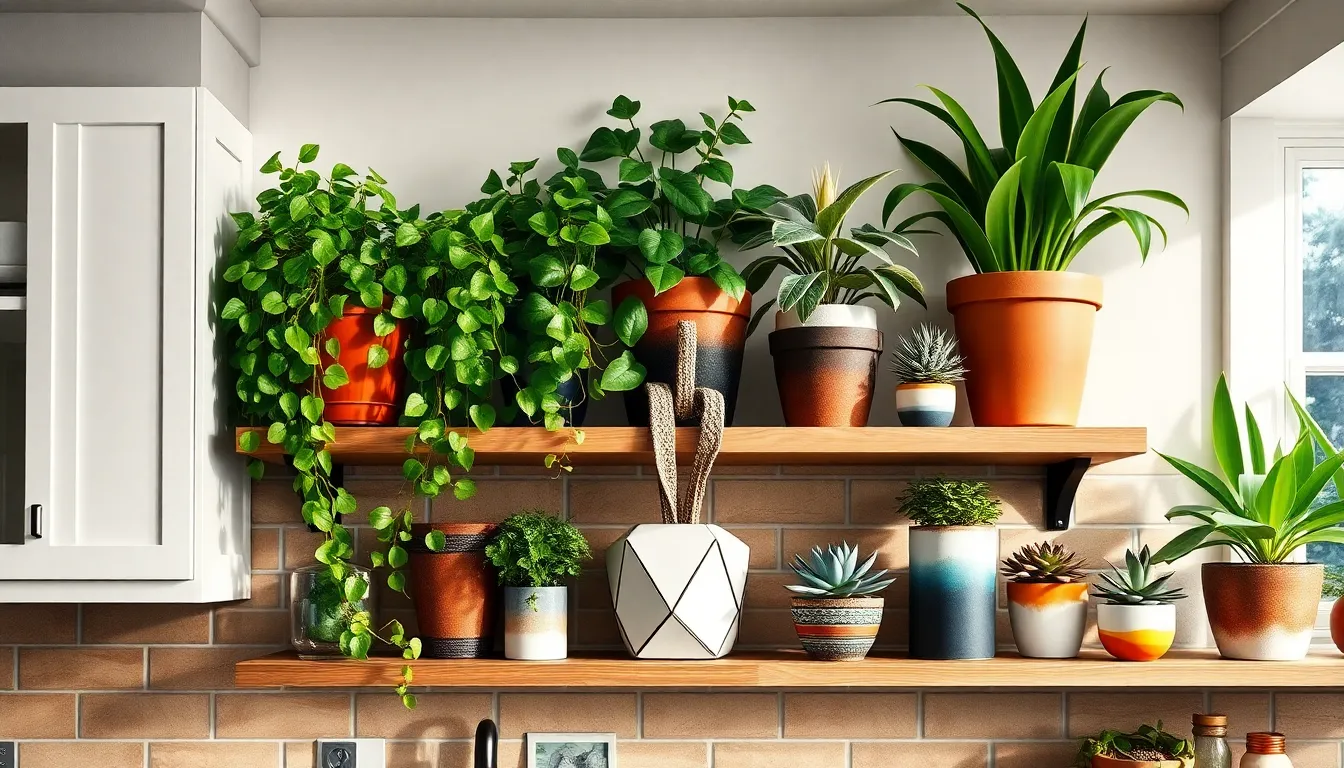
Creating a cohesive look with your cabinet top plants requires matching them to your kitchen’s overall design aesthetic. We’ll explore three popular styles that showcase how strategic plant choices can enhance your existing decor.
Farmhouse and Rustic Arrangements
Farmhouse kitchens thrive with plants that embrace natural, cozy arrangements that feel slightly wild and organic. Cascading greenery like ivy or pothos works beautifully in this setting, mimicking the feel of outdoor gardens spilling into your indoor space. Terra cotta pots and wooden containers complement rustic wood tones while adding authentic organic charm to your display.
Dried herbs create both visual appeal and practical value in farmhouse settings, offering fresh ingredients within arm’s reach. Succulents in weathered containers bring low maintenance beauty that fits perfectly with the farmhouse lifestyle. Woven baskets housing potted plants emphasize the handmade, warm vibe that defines this style.
Vintage style pots mixed with antique cookbooks or pottery collections enhance the welcoming atmosphere above your cabinets. Spider plants work exceptionally well for their hardy nature and ability to create beautiful cascading effects that soften cabinet edges.
Modern and Minimalist Approaches
Modern kitchens demand more restrained and architectural plant selections that maintain clean lines and uncluttered aesthetics. Snake plants excel in these spaces due to their sculptural shapes and striking vertical presence. ZZ plants offer another excellent choice with their glossy leaves and geometric growth patterns that complement contemporary design.
Ponytail palms bring architectural interest while requiring minimal maintenance, perfect for busy modern lifestyles. Sleek monochrome or geometric pots maintain the minimal aesthetic without competing with your kitchen’s design elements. Plant arrangements stay orderly and sparse rather than crowded, avoiding any cluttered appearance above the cabinets.
Lighting and plant size receive careful consideration to keep spaces feeling airy and uncluttered. Peace lilies add elegance with their broad leaves while fitting seamlessly into modern color palettes.
Bohemian and Eclectic Displays
Bohemian kitchens welcome variety in textures, colors, and pot styles that create lush and vibrant displays above your cabinets. Spider plants mixed with trailing succulents in colorful or patterned pots establish the playful, collected over time feel that defines boho style. Macramé pot holders add textural interest while supporting your hanging plant displays.
Colorful ceramics enhance the bohemian spirit when paired with plants of different heights and shapes. Layering creates the abundant and relaxed look that makes eclectic kitchens feel welcoming and personal. Natural elements mix beautifully with artistic or handmade decor pieces, giving your space authentic bohemian character.
Ivy and pothos varieties work wonderfully in bohemian settings, offering the trailing effects that soften cabinet lines while thriving in kitchen humidity conditions.
Solve Common Problems with Plants Above Kitchen Cabinets
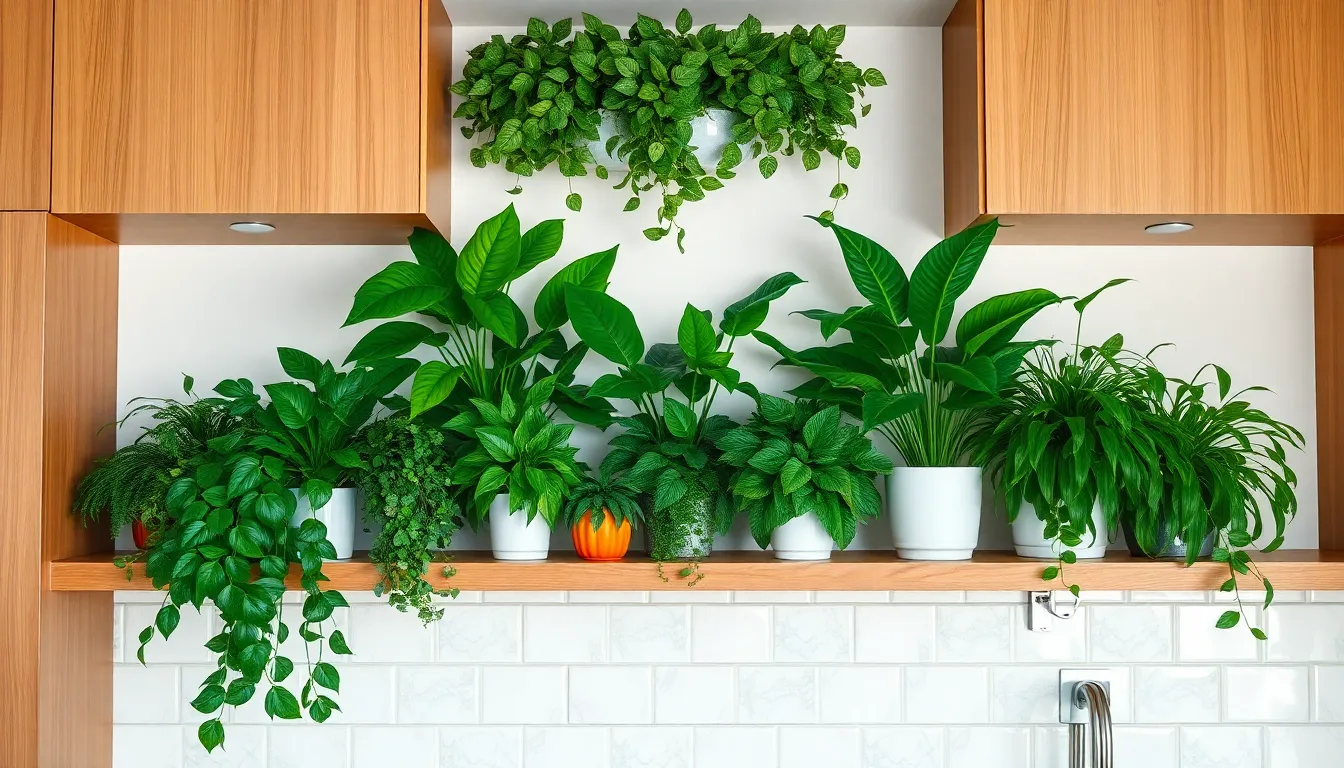
Even the most carefully planned plant displays can encounter challenges when positioned above kitchen cabinets. We’ve identified the three most common issues and developed practical answers to keep your elevated garden thriving.
Dealing with Grease and Kitchen Residue
Grease accumulation poses the biggest threat to plants positioned above kitchen cabinets. Cooking residues combined with dust create a sticky film that blocks light absorption and clogs plant pores, eventually affecting plant health and cleanliness.
Prevention starts with strategic placement. Position plants away from direct stovetop areas where grease particles are most concentrated. We recommend maintaining at least 3 feet of distance from your primary cooking zone to minimize exposure.
Regular cleaning becomes essential for plant survival. Wipe down leaves weekly using a damp microfiber cloth to remove grease buildup before it hardens. For artificial plants, this maintenance proves even simpler since you can rinse them directly in the sink without worrying about water damage.
Air circulation helps reduce residue accumulation. Install a quality range hood that effectively captures cooking vapors, and consider adding a small fan to improve airflow around your plant display area.
Managing Pest Issues in Elevated Spaces
Elevated kitchen spaces create unique pest challenges since they’re cleaned less frequently and can harbor food particles. Moisture from steam combined with reduced air circulation makes these areas attractive to various insects and promotes mold growth.
Plant selection dramatically reduces pest risks. Choose varieties that naturally resist common kitchen pests, such as snake plants and ZZ plants, which have thick, waxy leaves that bugs find less appealing. Avoid plants with soft, delicate foliage that attracts aphids and spider mites.
Routine inspection prevents major infestations. Check your plants monthly for signs of pests, looking for tiny webs, yellowing leaves, or small moving insects. Use a flashlight to examine the undersides of leaves where pests typically hide.
Cleanliness eliminates pest attractants. Wipe down the cabinet tops regularly to remove crumbs and spills that might attract ants or other insects. Keep the area dry and well ventilated to discourage mold and fungal growth.
Natural deterrents provide ongoing protection. Sprinkle cinnamon around plant bases or use neem oil spray monthly as a preventive measure against common kitchen pests.
Addressing Overwatering and Drainage Problems
Overwatering creates the most serious problems for plants above kitchen cabinets since excess water can damage cabinetry and lead to root rot. Limited drainage options in elevated spaces make water management particularly challenging.
Proper container selection prevents water damage. Use pots with drainage holes paired with waterproof saucers that won’t leak onto your cabinets. We recommend double potting, where you place a drainage pot inside a decorative outer container.
Drought tolerant plants eliminate watering stress. Choose varieties like pothos and snake plants that thrive with infrequent watering rather than moisture loving species that require constant attention. These plants can survive occasional neglect while maintaining their appearance.
Watering techniques minimize cabinet damage. Use long spouted watering cans to control water flow precisely, and check saucers 30 minutes after watering to remove any excess water. Consider self watering planters for consistent moisture without oversaturation.
Artificial alternatives remove watering concerns entirely. High quality silk plants provide the same visual appeal without any risk of water damage or drainage issues, making them ideal for areas where maintenance access is limited.
Moisture monitoring prevents root problems. Test soil moisture with your finger or a moisture meter before watering, and establish a schedule based on each plant’s exact needs rather than watering everything at once.
Conclusion
We’ve explored how plants above kitchen cabinets can completely transform your cooking space from a simple functional area into a vibrant living environment. Whether you choose low-maintenance succulents heat-tolerant varieties or dramatic trailing plants each option brings its own unique charm to your kitchen design.
The key to success lies in selecting plants that match your kitchen’s exact conditions and your lifestyle needs. From humidity-loving ferns to artificial alternatives there’s a perfect solution for every homeowner regardless of experience level or time constraints.
With proper placement techniques regular maintenance and thoughtful styling you’ll create a stunning display that enhances your kitchen’s aesthetic while bringing the calming benefits of nature indoors. Your guests will be amazed at how this simple addition elevates your entire space.
Frequently Asked Questions
What plants are best for placing above kitchen cabinets?
Heat-tolerant plants like snake plants, jade plants, ponytail palms, and ZZ plants work well above stoves. For humid areas, try Boston ferns, peace lilies, air plants, and spider plants. In low-light spots, pothos, Chinese evergreens, cast iron plants, and dracaena varieties thrive. All these options require minimal care while enhancing your kitchen’s visual appeal.
How do I safely secure plants above kitchen cabinets?
Use sturdy shelves or mounting racks that distribute weight across multiple points. Choose pots with drainage holes and waterproof saucers to prevent water damage. Ensure proper weight distribution and create accessible pathways for maintenance. Use tools like long-spouted watering cans and step stools for safe, easy access during care routines.
Can I use artificial plants above kitchen cabinets?
Yes, high-quality silk plants offer zero-maintenance appeal while closely mimicking living plants. Popular choices include silk Monstera, palms, birds of paradise, and cacti. Choose UV-resistant materials to prevent fading in sunny kitchens. Mix different plant types and heights for a natural look, requiring only occasional dusting to maintain freshness.
How do I maintain plants in hard-to-reach cabinet spaces?
Test soil moisture before watering and use long-spouted watering cans to minimize ladder use. Clean leaves regularly with feather dusters or damp cloths to remove kitchen grease and dust. Rotate plants periodically for even light exposure and prune strategically to maintain tidy appearances and encourage healthy growth.
What are common problems with cabinet-top plants and solutions?
Grease accumulation, pest issues, and overwatering are main concerns. Place plants away from stovetops, clean leaves regularly, and choose pest-resistant varieties. Use pots with drainage holes and self-watering planters to prevent overwatering. Monitor soil moisture and maintain proper ventilation to avoid mold and root rot issues.
How do I create visual balance with plants above cabinets?
Group 3-5 plants together, mixing different shapes and textures. Use height variation with taller plants in back and shorter ones in front. Coordinate pot colors with your kitchen’s palette and cabinet finishes. Layer plants at different depths to create visual interest and ensure the arrangement complements your kitchen’s design style.

